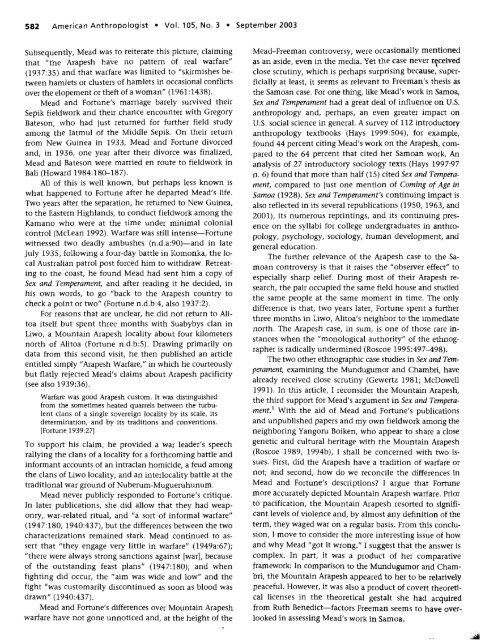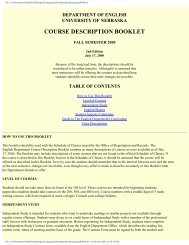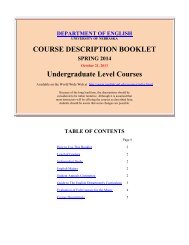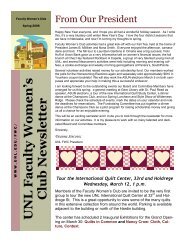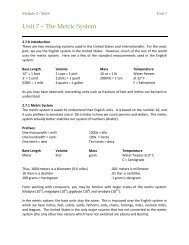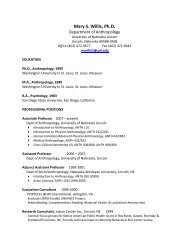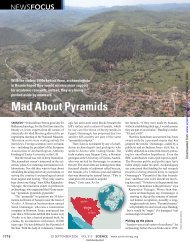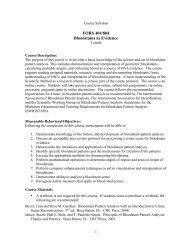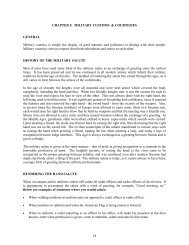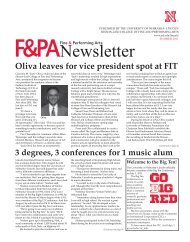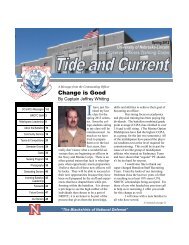Margaret Mead, Reo Fortune, and Mountain Arapesh Warfare
Margaret Mead, Reo Fortune, and Mountain Arapesh Warfare
Margaret Mead, Reo Fortune, and Mountain Arapesh Warfare
Create successful ePaper yourself
Turn your PDF publications into a flip-book with our unique Google optimized e-Paper software.
582 American Anthropologist • Vol. 105, No. 3 • September 2003<br />
Subsequently, <strong>Mead</strong> was to reiterate this picture, claiming<br />
that "the <strong>Arapesh</strong> have no pattern of real warfare"<br />
(1937:35) <strong>and</strong> that warfare was limited to "skirmishes between<br />
hamlets or clusters of hamlets in occasional conflicts<br />
over the elopement or theft of a woman" (1961:1438).<br />
<strong>Mead</strong> <strong>and</strong> <strong>Fortune</strong>'s marriage barely survived their<br />
Sepik fieldwork <strong>and</strong> their chance encounter with Gregory<br />
Bateson, who had just returned for further field study<br />
among the Iatmul of the Middle Sepik. On their return<br />
from New Guinea in 1933, <strong>Mead</strong> <strong>and</strong> <strong>Fortune</strong> divorced<br />
<strong>and</strong>, in 1936, one year after their divorce was finalized,<br />
<strong>Mead</strong> <strong>and</strong> Bateson were married en route to fieldwork in<br />
Bali (Howard 1984:180-187).<br />
All of this is well known, but perhaps less known is<br />
what happened to <strong>Fortune</strong> after he departed <strong>Mead</strong>'s life.<br />
Two years after the separation, he returned to New Guinea,<br />
to the Eastern Highl<strong>and</strong>s, to conduct fieldwork among the<br />
Kamano who were at the time under minimal colonial<br />
control (McLean 1992). <strong>Warfare</strong> was still intense—<strong>Fortune</strong><br />
witnessed two deadly ambushes (n.d.a:90)—<strong>and</strong> in late<br />
July 1935, following a four-day battle in Komonka, the local<br />
Australian patrol post forced him to withdraw. Retreating<br />
to the coast, he found <strong>Mead</strong> had sent him a copy of<br />
Sex <strong>and</strong> Temperament, <strong>and</strong> after reading it he decided, in<br />
his own words, to go "back to the <strong>Arapesh</strong> country to<br />
check a point or two" (<strong>Fortune</strong> n.d.b:4, also 1937:2).<br />
For reasons that are unclear, he did not return to Alitoa<br />
itself but spent three months with Suabybys clan in<br />
Liwo, a <strong>Mountain</strong> <strong>Arapesh</strong> locality about four kilometers<br />
north of Alitoa (<strong>Fortune</strong> n.d.b:5). Drawing primarily on<br />
data from this second visit, he then published an article<br />
entitled simply "<strong>Arapesh</strong> <strong>Warfare</strong>," in which he courteously<br />
but flatly rejected <strong>Mead</strong>'s claims about <strong>Arapesh</strong> pacificity<br />
(see also 1939:36).<br />
<strong>Warfare</strong> was good <strong>Arapesh</strong> custom. It was distinguished<br />
from the sometimes heated quarrels between the turbulent<br />
clans of a single sovereign locality by its scale, its<br />
determination, <strong>and</strong> by its traditions <strong>and</strong> conventions.<br />
[<strong>Fortune</strong> 1939:27]<br />
To support his claim, he provided a war leader's speech<br />
rallying the clans of a locality for a forthcoming battle <strong>and</strong><br />
informant accounts of an intraclan homicide, a feud among<br />
the clans of Liwo locality, <strong>and</strong> an interlocality battle at the<br />
traditional war ground of Nuberum-Mugueruhunum.<br />
<strong>Mead</strong> never publicly responded to <strong>Fortune</strong>'s critique.<br />
In later publications, she did allow that they had weaponry,<br />
war-related ritual, <strong>and</strong> "a sort of informal warfare"<br />
(1947:180, 1940:437), but the differences between the two<br />
characterizations remained stark. <strong>Mead</strong> continued to assert<br />
that "they engage very little in warfare" (1949a:67);<br />
"there were always strong sanctions against [war], because<br />
of the outst<strong>and</strong>ing feast plans" (1947-.180); <strong>and</strong> when<br />
fighting did occur, the "aim was wide <strong>and</strong> low" <strong>and</strong> the<br />
fight "was customarily discontinued as soon as blood was<br />
drawn" (1940:437).<br />
<strong>Mead</strong> <strong>and</strong> <strong>Fortune</strong>'s differences over <strong>Mountain</strong> <strong>Arapesh</strong><br />
warfare have not gone unnoticed <strong>and</strong>, at the height of the<br />
<strong>Mead</strong>-Freeman controversy, were occasionally mentioned<br />
as an aside, even in the media. Yet the case never received<br />
close scrutiny, which is perhaps surprising because, superficially<br />
at least, it seems as relevant to Freeman's thesis as<br />
the Samoan case. For one thing, like <strong>Mead</strong>'s work in Samoa,<br />
Sex <strong>and</strong> Temperament had a great deal of influence on U.S.<br />
anthropology <strong>and</strong>, perhaps, an even greater impact on<br />
U.S. social science in general. A survey of 112 introductory<br />
anthropology textbooks (Hays 1999:504), for example,<br />
found 44 percent citing <strong>Mead</strong>'s work on the <strong>Arapesh</strong>, compared<br />
to the 64 percent that cited her Samoan work. An<br />
analysis of 27 introductory sociology texts (Hays 1997:97<br />
n. 6) found that more than half (15) cited Sex <strong>and</strong> Temperament,<br />
compared to just one mention of Coming of Age in<br />
Samoa (1928). Sex <strong>and</strong> Temperament's continuing impact is<br />
also reflected in its several republications (1950, 1963, <strong>and</strong><br />
2001), its numerous reprintings, <strong>and</strong> its continuing presence<br />
on the syllabi for college undergraduates in anthropology,<br />
psychology, sociology, human development, <strong>and</strong><br />
general education.<br />
The further relevance of the <strong>Arapesh</strong> case to the Samoan<br />
controversy is that it raises the "observer effect" to<br />
especially sharp relief. During most of their <strong>Arapesh</strong> research,<br />
the pair occupied the same field house <strong>and</strong> studied<br />
the same people at the same moment in time. The only<br />
difference is that, two years later, <strong>Fortune</strong> spent a further<br />
three months in Liwo, Alitoa's neighbor to the immediate<br />
north. The <strong>Arapesh</strong> case, in sum, is one of those rare instances<br />
when the "monological authority" of the ethnographer<br />
is radically undermined (Roscoe 1995:497-498).<br />
The two other ethnographic case studies in Sex <strong>and</strong> Temperament,<br />
examining the Mundugumor <strong>and</strong> Chambri, have<br />
already received close scrutiny (Gewertz 1981; McDowell<br />
1991). In this article, I reconsider the <strong>Mountain</strong> <strong>Arapesh</strong>,<br />
the third support for <strong>Mead</strong>'s argument in Sex <strong>and</strong> Temperament.<br />
1 With the aid of <strong>Mead</strong> <strong>and</strong> <strong>Fortune</strong>'s publications<br />
<strong>and</strong> unpublished papers <strong>and</strong> my own fieldwork among the<br />
neighboring Yangoru Boiken, who appear to share a close<br />
genetic <strong>and</strong> cultural heritage with the <strong>Mountain</strong> <strong>Arapesh</strong><br />
(Roscoe 1989, 1994b), I shall be concerned with two issues.<br />
First, did the <strong>Arapesh</strong> have a tradition of warfare or<br />
not; <strong>and</strong> second, how do we reconcile the differences in<br />
<strong>Mead</strong> <strong>and</strong> <strong>Fortune</strong>'s descriptions? I argue that <strong>Fortune</strong><br />
more accurately depicted <strong>Mountain</strong> <strong>Arapesh</strong> warfare. Prior<br />
to pacification, the <strong>Mountain</strong> <strong>Arapesh</strong> resorted to significant<br />
levels of violence <strong>and</strong>, by almost any definition of the<br />
term, they waged war on a regular basis. From this conclusion,<br />
I move to consider the more interesting issue of how<br />
<strong>and</strong> why <strong>Mead</strong> "got it wrong." I suggest that the answer is<br />
complex. In part, it was a product of her comparative<br />
framework: In comparison to the Mundugumor <strong>and</strong> Chambri,<br />
the <strong>Mountain</strong> <strong>Arapesh</strong> appeared to her to be relatively<br />
peaceful. However, it was also a product of covert theoretical<br />
licenses in the theoretical gestalt she had acquired<br />
from Ruth Benedict—factors Freeman seems to have overlooked<br />
in assessing <strong>Mead</strong>'s work in Samoa.


